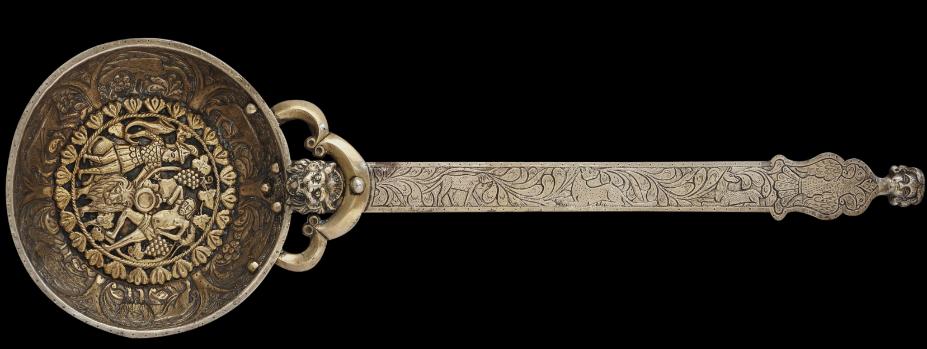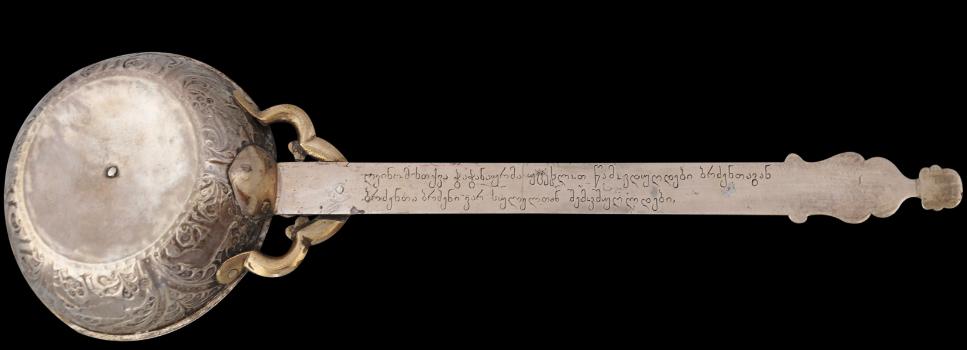
Caucasus Georgian Silver Wine Ladle
Inscribed Parcel-Gilt Silver Wine Ladle (Azarpeshi)
Georgia
circa 1820
length: 42cm, diameter: of bowl: 12.3cm, weight: 340g
This is a particularly fine and unusually large Caucasian azarpeshi ladle. The ladle is of traditional form with a circular, lipped shallow bowl and a long handle with cusped terminals that attach to the bowl on either side of a well-cast lion’s head. The handle is cast with the head of a female (or perhaps a youth) as a finial, and is engraved with a hunting dog and two deers amid scrolling foliage and with a double-headed bird motif.
The bowl unusually has an open-work movable silver disk attached to its base which is decorated with the figures of two revellers amid grape vines and bunches of grapes and standing on either side of a lion. One of the figures holds a drinking horn. The other holds a large
azarpeshi not unlike this example. The interior sides of the bowl are engraved with arches filled with birds, a lion, a boar, a hunting dog and so on, all amid foliage.
The cusped finials, the interior sides of the bowl, and the disk in the base of the bowl have all been mercury-fire gilded.
The reverse side of the handle has a long engraved inscription in Georgian. This has been kindly translated by Alexander Bainbridge to read:
ღვინომ სთქვა ჭაჭანაურმა | უცეცხლოთ წამავდუღდები | ბრძენთაგან ბრძენთა ბრძენი ვარ | სულელთან შემავშუღლდები
ghvinom stkva ch’ach’anaurma | utsetskhlot ts’amavdughdebi | brdzentagan brdzenta brdzeni var | suleltan shemavshughldebi
The ch’ach’anauri wine said | I will boil without fire | among wise men I am the wisest of the wise | I will quarrel with a fool.
(Note: The word ch’ach’anauri, used here as an adjective, is an epithet for ‘wine’, and literally means ‘made of grape skins’.)
Ladles such as these were used at large Georgian feasts such as those associated with weddings to drink wine. Each drinker had a ladle and the wine was
ladled to the mouth from a large communal bowl or vat.
Each festival or feast had its own fixed, communal formula. The
tamada or toast-master was the lead figure. He was required to propose toasts for all present,
following strict rules of precedence. He also announced when there would be music, singing and dancing. The
tamada usually was elected from among the
most eloquent present.
A wine ladle of this size and fineness would have belonged to a particularly wealthy or even aristocratic owner. Certainly, it is one of the finest examples that we have seen. It is supplied with a custom-made stand.
References
Alexander Bainbridge, pers. comm., 2015.
The Caucasian Peoples, catalogue for an exhibition of the Russian Ethnographic Museum, staged at the Hessenhuis, Antwerp, Belgium, 2001.Provenance
UK art market
Inventory no.: 1234
SOLD








